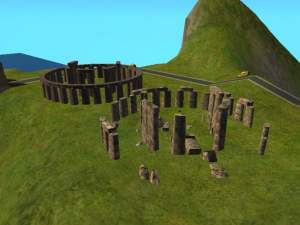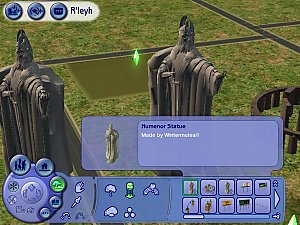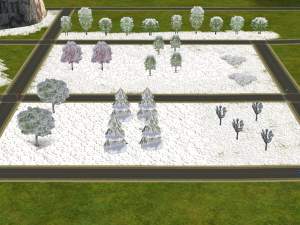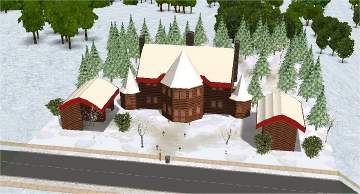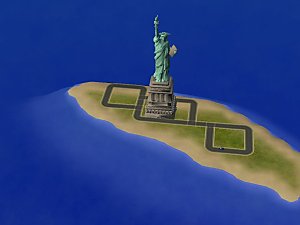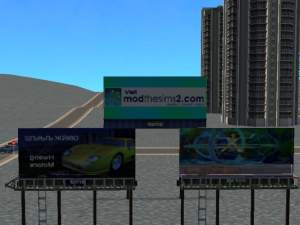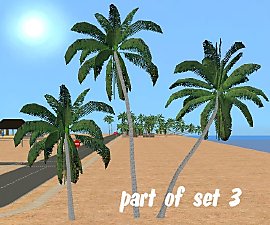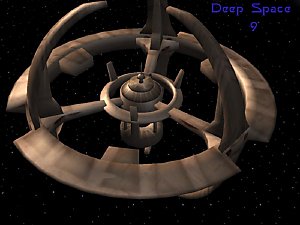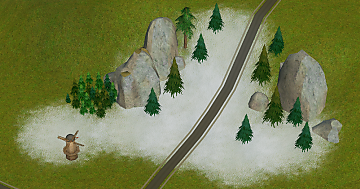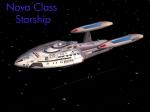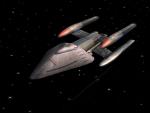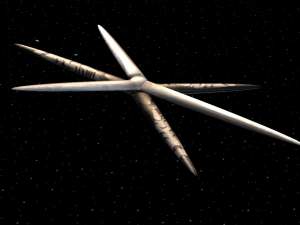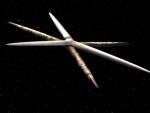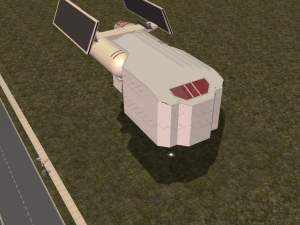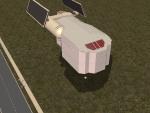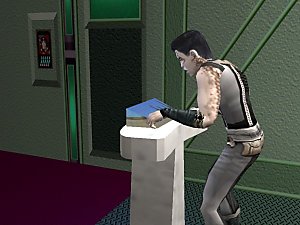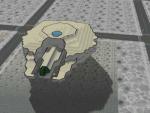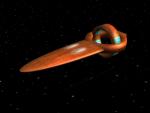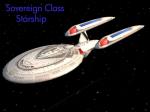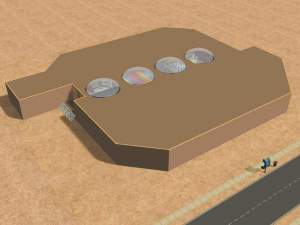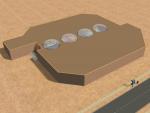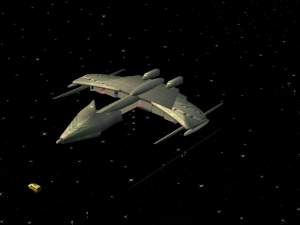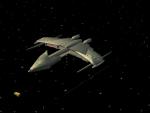 Planets- A set of Neighborhood objects
Planets- A set of Neighborhood objects

Planets 1.jpg - width=700 height=525

Planets 2a.jpg - width=600 height=450

Planets 3a.jpg - width=650 height=488

Planets 4a.jpg - width=600 height=450

Planets 5a.jpg - width=600 height=450

Planets 6a.jpg - width=650 height=488

Planets 7a.jpg - width=650 height=488

Planets 8.jpg - width=650 height=488
Class A Planets (gas giants) are usually found in a star's outer or "cold zone". They are typically 50 thousand to 140 thousand kilometers in diameter and have high core temperatures but do not radiate much heat. Low stellar radiation and high planet gravity enables them to keep a tenuous surface comprised of gaseous hydrogen and hydrogen compounds. Examples- Sol 6 (Saturn) and Sol 8 (Neptune)
I've included 2 different sets, with and without rings

Class C planets- Planets of this class are usually found in a star's "habitable zone". They are typically 10 to 15 thousand kilometers in diameter. They have high surface temperatures due to the "greenhouse effect" caused by their dense atmospheres. The only water found is in vapor form. Example: Sol 2 (Venus)

Class J planets- Planets of this class are found in a star's "hot zone". They are typically 1,000 to 10,000 kilometers in diameter. They have high surface temperatures due to the proximty to the star. Their atmospheres are extremely tenuous with few chemically active gases. Example- Sol 1 (Mercury)
Class M Planets- Terrestrial Planets of this class are found in a star's "habitable zone". They are typically 10,000 to 15 thousand kilometers in diameter. They have atmospheres that contain oxygen and nitrogen . Water and life-forms are typically abundant. If water covers more than 97% of the surface, then they are considered Class N. Example- Sol 3 (Earth)
Class N Planets- Pelagic Class N planets are usually found in a star's "habitable zone". They are typically 10,000 to 15 thousand kilometers in diameter. They have atmospheres that contain oxygen and nitrogen . Water and life-forms are typically abundant.

I've also included a wormhole in this set. The wormhole is pictured here:

Polygon Counts:
Class A Planet: 1984
Class C Planet: 1984
Class A Planet with Rings: 3520
Class J Planet: 1984
Class M Planet: 1984
Class N Planet: 1984
Wormhole: 651
|
Wormhole.rar
Download
Uploaded: 12th Aug 2008, 56.6 KB.
3,931 downloads.
|
||||||||
|
Class M and N Planets (7).rar
Download
Uploaded: 12th Aug 2008, 578.3 KB.
4,477 downloads.
|
||||||||
|
Class J Planets (4).rar
Download
Uploaded: 12th Aug 2008, 301.5 KB.
4,030 downloads.
|
||||||||
|
Class C Planets (6).rar
Download
Uploaded: 12th Aug 2008, 468.5 KB.
3,907 downloads.
|
||||||||
|
Class A Planets- Rings (4).rar
Download
Uploaded: 12th Aug 2008, 411.7 KB.
4,241 downloads.
|
||||||||
|
Class A Planets (3).rar
Download
Uploaded: 12th Aug 2008, 214.7 KB.
4,415 downloads.
|
||||||||
| For a detailed look at individual files, see the Information tab. | ||||||||
Install Instructions
1. Download: Click the download link to save the .rar or .zip file(s) to your computer.
2. Extract the zip, rar, or 7z file.
3. Place in Downloads Folder: Cut and paste the .package file(s) into your Downloads folder:
- Origin (Ultimate Collection): Users\(Current User Account)\Documents\EA Games\The Sims™ 2 Ultimate Collection\Downloads\
- Non-Origin, Windows Vista/7/8/10: Users\(Current User Account)\Documents\EA Games\The Sims 2\Downloads\
- Non-Origin, Windows XP: Documents and Settings\(Current User Account)\My Documents\EA Games\The Sims 2\Downloads\
- Mac: Users\(Current User Account)\Documents\EA Games\The Sims 2\Downloads
- Mac x64: /Library/Containers/com.aspyr.sims2.appstore/Data/Library/Application Support/Aspyr/The Sims 2/Downloads
- For a full, complete guide to downloading complete with pictures and more information, see: Game Help: Downloading for Fracking Idiots.
- Custom content not showing up in the game? See: Game Help: Getting Custom Content to Show Up.
- If you don't have a Downloads folder, just make one. See instructions at: Game Help: No Downloads Folder.
Loading comments, please wait...
-
Stonehenge - *NEW Neighborhood Objects!*
by Numenor 17th Oct 2005 at 10:02am
 129
136.1k
63
129
136.1k
63
Miscellaneous » Neighborhoods & CAS Screens » Neighbourhood Deco
-
by wintermuteai1 24th Oct 2005 at 8:44pm
 74
83.6k
41
74
83.6k
41
Miscellaneous » Neighborhoods & CAS Screens » Neighbourhood Deco
-
Snow rocks for your Neighborhood!!!
by OoGaBbErZiCkEoO 15th Nov 2005 at 12:26pm
 8
19.6k
12
8
19.6k
12
Miscellaneous » Neighborhoods & CAS Screens » Neighbourhood Deco
-
by OoGaBbErZiCkEoO 15th Nov 2005 at 5:53pm
 23
28.4k
10
23
28.4k
10
Miscellaneous » Neighborhoods & CAS Screens » Neighbourhood Deco
-
Neighborhood Snow Terrain (covers desert)
by hrussio 27th Nov 2005 at 8:40am
 +1 packs
37 37k 4
+1 packs
37 37k 4 Nightlife
Nightlife
Miscellaneous » Neighborhoods & CAS Screens » Neighbourhood Deco
-
Statue of Liberty for your neighborhood!!!
by OoGaBbErZiCkEoO 1st Dec 2005 at 10:47pm
 +1 packs
25 58.4k 55
+1 packs
25 58.4k 55 Nightlife
Nightlife
Miscellaneous » Neighborhoods & CAS Screens » Neighbourhood Deco
-
by simaster8 15th Jul 2006 at 12:20am
 +2 packs
5 26.6k 30
+2 packs
5 26.6k 30 Nightlife
Nightlife
 Open for Business
Open for Business
Miscellaneous » Neighborhoods & CAS Screens » Neighbourhood Deco
-
Alex_Stanton1983's palms for neighborhood
by alex_stanton1983 27th Jan 2007 at 4:55pm
 22
36.6k
46
22
36.6k
46
Miscellaneous » Neighborhoods & CAS Screens » Neighbourhood Deco
-
Starbases as Neighborhood Objects
by jasonduskey 29th Oct 2008 at 4:41pm
 14
24.6k
19
14
24.6k
19
Miscellaneous » Neighborhoods & CAS Screens » Neighbourhood Deco
-
Neighborhood "Permafrost" Decoration
by terenetwo 11th Jan 2024 at 5:45pm
 14
5k
27
14
5k
27
Miscellaneous » Neighborhoods & CAS Screens » Neighbourhood Deco
-
by jasonduskey 5th Jul 2008 at 2:20am
From Memory Alpha: "The Nova class was one of Starfleet's most advanced scientific vessels, emerging as a replacement for more...
 +6 packs
9 21.9k 9
+6 packs
9 21.9k 9 University
University
 Nightlife
Nightlife
 Open for Business
Open for Business
 Pets
Pets
 Seasons
Seasons
 Bon Voyage
Bon Voyage
-
by jasonduskey 27th Mar 2008 at 4:05am
The Prometheus class is a truly unique starship, part of a trend by Starfleet engineers to develop smaller, faster, more more...
 +6 packs
4 19.6k 4
+6 packs
4 19.6k 4 University
University
 Nightlife
Nightlife
 Open for Business
Open for Business
 Pets
Pets
 Seasons
Seasons
 Bon Voyage
Bon Voyage
-
by jasonduskey 5th Mar 2008 at 4:51am
This is a Cylon capital ship from Battlestar Galactica. more...
 +6 packs
4 6.6k
+6 packs
4 6.6k University
University
 Nightlife
Nightlife
 Open for Business
Open for Business
 Pets
Pets
 Seasons
Seasons
 Bon Voyage
Bon Voyage
-
by jasonduskey 18th Sep 2007 at 8:07pm
Included on this thread are Slave 1, Hound's Tooth, IG-2000, Punishing One, and Mist Hunter Lot Size: 3x3 Lot Price: more...
 +2 packs
4 9.1k 5
+2 packs
4 9.1k 5 University
University
 Pets
Pets
-
by jasonduskey 7th Jan 2008 at 1:21am
My original intent when I created my standing consoles was to make them "operable" somehow. more...
 +1 packs
21 17.7k 21
+1 packs
21 17.7k 21 University
University
-
by jasonduskey 1st Aug 2007 at 9:46pm
Aaah, my first upload. I posted these 2 lots on the same thread for the purpose of consolidation. more...
 +5 packs
7 7.4k 1
+5 packs
7 7.4k 1 University
University
 Nightlife
Nightlife
 Open for Business
Open for Business
 Pets
Pets
 Seasons
Seasons
-
by jasonduskey 16th Mar 2008 at 3:50am
The D'kyr Type Starship was used primarily by the Vulcan High Command and was designated a combat cruiser. more...
 +6 packs
5 8.4k 1
+6 packs
5 8.4k 1 University
University
 Nightlife
Nightlife
 Open for Business
Open for Business
 Pets
Pets
 Seasons
Seasons
 Bon Voyage
Bon Voyage
-
Sovereign Class Starship- 3rd Gen Remodel
by jasonduskey 29th Jun 2008 at 4:37pm
From Memory Alpha: "The Sovereign-class starship was introduced in more...
 +6 packs
12 18.5k 10
+6 packs
12 18.5k 10 University
University
 Nightlife
Nightlife
 Open for Business
Open for Business
 Pets
Pets
 Seasons
Seasons
 Bon Voyage
Bon Voyage
-
by jasonduskey 15th Mar 2008 at 2:05pm
"Mos Eisley Spaceport. You will never find a more wretched hive of scum and villainy. more...
 +6 packs
5 19.8k 5
+6 packs
5 19.8k 5 University
University
 Nightlife
Nightlife
 Open for Business
Open for Business
 Pets
Pets
 Seasons
Seasons
 Bon Voyage
Bon Voyage
-
Valdore Type Warbird- Updated 2-15-08
by jasonduskey 9th Jan 2008 at 3:41am
I have always liked the shape of this ship. more...
 +6 packs
16 7.1k 2
+6 packs
16 7.1k 2 University
University
 Nightlife
Nightlife
 Open for Business
Open for Business
 Pets
Pets
 Seasons
Seasons
 Bon Voyage
Bon Voyage
About Me
https://blueheavensims.wordpress.com
Terms of Use:
You may recolor my objects + architecture
You may clone my stuff, but credit it back to me
You may use my objects on your lots
You may alter my stuff for your own projects, but credit it back to me
You may not post my stuff on the Exchange or paysites. Keep it free.

 Sign in to Mod The Sims
Sign in to Mod The Sims






